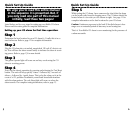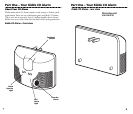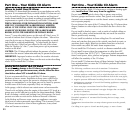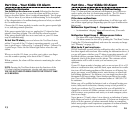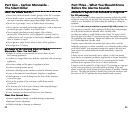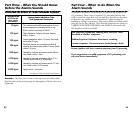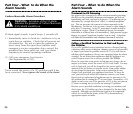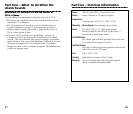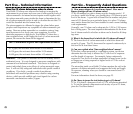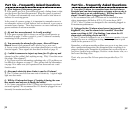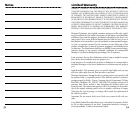
2423
Part Four – What to do When the
Alarm Sounds
Determine if anyone in the household is experiencing symptoms of
CO poisoning. Many cases of reported CO poisoning indicate that
while victims are aware they are not well, they become so disorient-
ed that they are unable to save themselves by either exiting the
building or calling for assistance. Also young children and household
pets may be the first affected. The following symptoms are related to
CARBON MONOXIDE POISONING and should be discussed with
ALL members of the household:
Mild Exposure: Headaches, running nose, sore eyes, often
described as "flu-like" symptoms.
Medium Exposure: Dizziness, drowsiness, vomiting.
Extreme Exposure: Unconsciousness, brain damage, death.
Become familiar with these common symptoms from CO poisoning.
If you experience even mild symptoms of CO poisoning, con-
sult your doctor immediately!
Part Three – What You Should Know
Before the Alarms Sounds
The maximum allowable concentration for con-
tinuous exposure for healthy adults in any
8-hour period, according to OSHA*.
Slight headache, fatigue, dizziness, nausea
after 2-3 hours.
Frontal headaches within 1-2 hours, life threat-
ening after 3 hours.
Dizziness, nausea and convulsions within 45
minutes. Unconsciousness within 2 hours. Death
within 2-3 hours.
Headache, dizziness and nausea within 20 min-
utes. Death within 1 hour.
Headache, dizziness and nausea within 5-10
minutes. Death within 25-30 minutes.
Headache, dizziness and nausea within 1-2 min-
utes. Death within 10-15 minutes.
Death within 1-3 minutes.
50 ppm
200 ppm
400 ppm
800 ppm
1 600 ppm
3 200 ppm
6 400 ppm
12 800 ppm
Concentration
of CO in Air
(ppm = parts
per million)
Approximate Inhalation Time
and Symptoms Developed
* Occupational Safety and Health Administration
Understand the Effects of Carbon Monoxide Exposure
Reminder: The chart above relates to the exposure of healthy adults.
Read the info on the previous page for descriptions of those who are at
higher risk.



